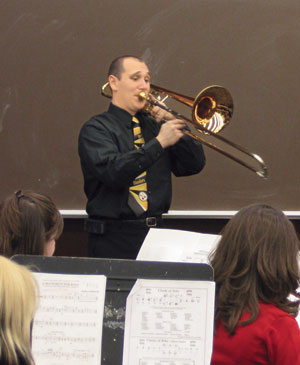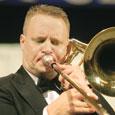 As a special feature of the school year, many high school concert bands host a spring music festival that includes a concerto performance. While some directors feature their best senior instrumentalists or hold a concerto contest and present the winner, others invite a guest soloist or returning alumnus to perform with the band. No matter the approach, the responsibility of locating the right music – matching the ability of the soloist with the level of the accompanying ensemble – can be daunting.
As a special feature of the school year, many high school concert bands host a spring music festival that includes a concerto performance. While some directors feature their best senior instrumentalists or hold a concerto contest and present the winner, others invite a guest soloist or returning alumnus to perform with the band. No matter the approach, the responsibility of locating the right music – matching the ability of the soloist with the level of the accompanying ensemble – can be daunting.
The following selections can help. Most of these gems are available through music distributors, and you can find those that are out of print in fine university wind band libraries. Several selections are well known for their instrument and are easily available, and some include additional information about interpreting the music that will be helpful during score study. The longer list in the sidebar includes shorter and easier works that might be better suited to less-experienced soloists and accompanying ensembles.
Flute
Concertino, Op. 107 (Carl Fischer) is an eight-minute work for solo flute and piano accompaniment by Cécile Chaminade (1857-1944), arranged by Clayton Wilson for flute and wind band, published in 1960. Revolving around the key of D, the scoring suggests one to a part when accompanying the solo flute; however, the parts are straightforward and should not be problematic for a grade four high school band.
Romantic in nature, the piece features several themes and transitions that move between soloist and accompanying parts. The work has only a condensed score, a lengthy cadenza for the soloist, and an optional cut that eliminates a rhythmic section for the solo.
Oboe
Charles T. Yeago has transcribed two excellent oboe concertos for wind band. Alessandro Marcello’s Concerto in C Minor (BAS Publications), originally with accompanying strings, shows Yeago’s attention to detail and historical accuracy. This particular edition provides conductors with two versions of the oboe solo because of the inconsistencies Yeago found in his historical research. The soloist and conductor are left to decide which version to perform. The accompanying parts are interesting and playable while being transparent enough for the solo voice to be heard. While the publisher indicates a grade three for the wind parts, they appear to merit a more difficult rating of four because of the speed and lightness required for articulated passages.
Yeago’s second transcription, the Sonata in A Minor by Georg P. Telemann (BAS Publications), demonstrates the same excellent scoring with interesting colors and care for the soloist in which the texture of the accompanying parts are thinned out to allow the featured oboe to be heard with ease. Yeago suggests reducing the number of players throughout the work to allow the oboe solo to project. At a length of five minutes, this work is suitable for high school musicians to perform. BAS Publications includes recordings of these works at its website, www.baspublishing.com.
Clarinet
Carl von Weber composed several works that have been transcribed for clarinet solo and wind band. Concertino, Op. 26 (Carl Fischer), arranged by M.W. Lake, is quite playable by a high school soloist and accompaniment, and at eight minutes in length it is not overly long to program. Featuring a variety of moods, the music will challenge directors to establish the correct tempo for solo and ensemble. The clarinets provide much of the background, continuing to play through the entire transcription. Woodwind players should easily master a few difficult notes that move quickly but are not as difficult as they appear. The final variation in 68 will require extra rehearsal time to solidify the rhythmic difficulty of the meter, however, the key of F makes this a playable selection.
The Fantasia and Rondo (Kendor), arranged by Jack Snavely, is more difficult for the soloist because of longer, more exposed passages and more difficult technique, but it is as playable as the Concertino, which is just a little longer at nine minutes.
T. Conway Brown’s arrangement of von Weber’s Second Concerto (Boosey & Hawkes) is the most difficult of the three works in this compilation for both the soloist and the ensemble. It is the most substantial in scope with three movements and 23 minutes of playing time.
Bassoon
The Allegro movement of the Concerto in B flat (BAS Publications) by W.A. Mozart, transcribed for wind band by Charles T. Yeago, requires a light articulation to represent the Classical style. The key is friendly to wind players, and the transcription has transparent parts that bring the soloist to the forefront.
The first horn part has high As during the theme and a sustained high G at a pp dynamic that could prove problematic to the performer. The solo part is easily mamageable; it includes alternate parts and an optional cadenza that make the work challenging.
Saxophone
The Introduction and Samba by Maurice Whitney (Bourne) for alto saxophone and band is a dramatic work and only available through rental. The soloist has the option to feature the brilliance of the altissimo register throughout the work. Double tonguing is required by trumpets, trombones, flutes, and by the soloist. This solo is not as technically difficult as other works within the cannon of saxophone music, and the accompaniment is not overly difficult. Full scoring of the ensemble is rarely used, allowing for easy balance between solo and ensemble.
Trumpet
The Haydn and Hummel trumpet concertos (Chappell/Hal Leonard, Robert King) are widely regarded as two of the most well-known selections for the instrument and common in many standard solo lists. Both concertos have been transcribed for wind band and share several similarities. First, the solo trumpet parts are designed for an E-flat instrument and should be performed on one when at all possible. Second, the transcriptions are often thickly scored in the woodwinds, which substitute for the original string parts. These woodwind parts require strong performers, especially in the clarinet section.
Finally, arrangements of one or two movements of these concertos with judicious cuts of the introductions or bridges make them more suitable for high school ensembles. James Curnow has arranged the middle movements of both selections, making the solo and ensemble accompaniment worthwhile for high school groups.
The Concerto for Trumpet by Alexander Arutiunian, transcribed by Guy M. Duker (Thompson Music), is another standard work for trumpet. This rendition for the full instrumentation of the wind band is an endurance and technical challenge for the soloist. Duker’s transcription maintains the color changes of the orchestral piece, displaying transparency while keeping the parts playable. The Romantic flair of the composition requires numerous transitions and changes in style that will make this work an interpretive challenge for the conductor and solo.
Horn
Several Mozart concertos for horn and wind band (Southern), edited by Lorenzo Sansone, are transposed from the original key to accommodate modern horns. The transcriptions rely heavily on the clarinet section while eliminating parts for trumpet, trombone, and euphonium. The limited instrumentation creates good balance; however, players should keep Classical-era performance practice in mind and use a light articulation throughout. These concertos are sold with full scores for the conductor.
Trombone
Waber Naillin transcribed Nicolai Rimsky-Korsakov’s Concerto for Trombone (Ludwig- Masters, Hal Leonard reprint), creating a playable work for most high school wind bands with the exception of a difficult clarinet part. Performers have to maintain a light articulation throughout the 11-minute transcription. Saxophones are optional. Directors may shorten the work by performing only the first movement or only the second and third movements.
Alexandre Guilmant’s Morceau Symphonique, transcribed by Wesley Shepard, has been reissued by (Belwin-Mills/Alfred). It is a relatively short, six-minute selection that is playable by the soloist and wind band alike. The score’s abbreviated form should not prohibit directors from considering the selection for their next concert.
Andante and Allegro by J.E. Barat is another fine selection for solo trombone or solo euphonium. Romantic in flavor, the arrangement by Robert L. Marsteller (Southern) features a variety of colors but can at times be too thickly scored. There are a few problematic measures for the woodwinds that will require extra attention, and the especially high parts for clarinets 1 and 2 include two introductions that will challenge the fingers. The low reeds play a difficult moving bass line early in the work that requires practice. Overall, the work will best be performed by a mature ensemble that can handle its transitions and changes, more than the technique required by the music.
Euphonium
Robert W. Smith’s Willson Suite (Belwin-Mills/Alfred) has several unusual features, such as a solo part with four options for the conductor to consider: the euphonium solo as conceived by Smith and also a more difficult version as performed by re-nowned euphonium soloist Roger Behrend. Smith also provides a transcription of both versions for solo tuba, changing to the appropriate octave when necessary.
In addition, Smith captures the character and traits of his well-known compositional style for wind band in this composition. Performers’ parts include directions to create atmospheric effects, and the percussion scoring uses ample instrumentation that is integrated into the score; rhythm is an important element of the work. Ensemble members will have fun performing this work. The piano part is crucial to a representative performance.
Tuba
Don Haddad’s Suite for Tuba (Shawnee Press) has been scored, as the composer notes, to enable the solo to be heard by featuring the woodwinds. Brass have articulate moments, punctuating chords, and marking accents. The ensemble accompaniment is easily playable and the length – just over seven minutes – is easily manageable, allowing for many expressive moments by the tuba soloist. The biggest challenge is in the third movement where the rhythmic and technical difficulties will require careful practice.
Fantasia for Tuba by James Curnow (Curnow Music Press) is more challenging than the Suite for Tuba. The entire work is based on the development of a four-note motive heard in the free section that opens the piece. The scoring, which uses a full complement of percussion, features a variety of writing styles for the accompaniment, from tutti band to thin and transparent textures. Curnow designates specific dynamics in the wind band parts in an attempt to prevent inherit balance problems when working with a solo performer. A full range of style, dynamics, and emotional effects are explored in this work for tuba.
Percussion
Randy Eyles and Floyd Werle have combined forces to create two xylophone solos with band: Golden Age of the Xylophones and Rainbow Ripples (Meredith Music/Hal Leonard). Both solo xylophone parts have difficult rapid 16th-note passages, but the up-tempo themes and effect of the arrangements preserve the spirit of the ragtime piano themes made famous by xylophonist George Hamilton Green. Woodwinds play fast articulated passages, and the brass must avoid covering the soloist and woodwinds.
While this is not meant to be a comprehensive list, it should inspire band directors who have never before featured a soloist with their ensembles. Moreover, it will give students the thrill of performing as a soloist, and it will give ensembles the opportunity to collaborate with other musicians in a performance, creating lifelong musical memories for everyone. l
For a longer list of instrumental solos with band.
Contributors to this article are James Cochran of Shattinger Music, St. Louis, Missouri; Volkwein’s Music, Pittsburgh, Pennsylvania; and the following music faculty of Youngstown State University: Michael R. Crist, professor of trombone; Brian D. Kiser, assistant professor of tuba and euphonium; James C. Umble, professor of saxophone; and Kathryn Thomas Umble, assistant professor of flute.





